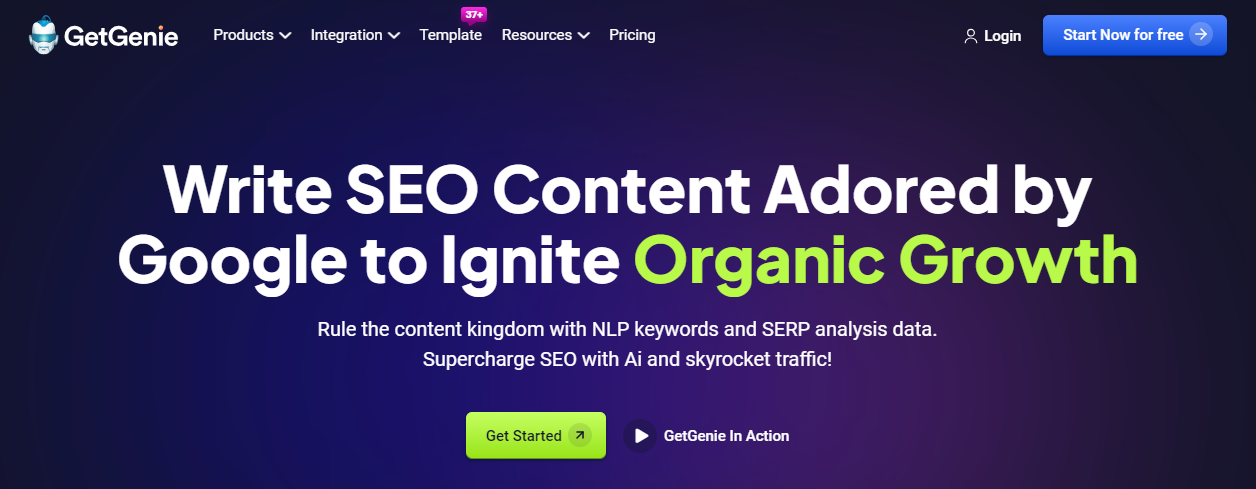Content Gap Analysis: The Secret to Outrank Your Competitors

To rank content higher in Google’s SERP, you can’t just repeat what others have covered in their pieces. Rather, you have to find gaps in your competitors’ content and fill up the gaps in your content pieces with high-quality & helpful content.
You also need to discover topics in your niche that are still untouched. Obviously, keyword search volume & difficulty matter a lot in this case if you want to drive decent or high organic traffic to your webpage. Sometimes, a topic might have been covered, but a related section has been missed.
In both cases, the SEO content gap analysis comes into play. This write-up will exclusively deal with SEO content gap analysis and help you discover missing points in your competitors’ content strategy. This will help you outrank them and drive qualified traffic to your site.
To run a successful content gap analysis and uncover growth opportunities for your SEO strategy:
Sketch the customer journey – Map user needs across awareness, consideration, and decision stages.
Perform market analysis – Study how competitors position content and where they leave gaps.
Do a content audit – Review your site for missing, thin, or overlapping content.
Run a keyword & SERP gap check – Find competitor keywords and topics you don’t cover.
Measure performance metrics – Track keyword ranking, organic ranking, time on page, bounce rate, pages per session, CTR, conversion rate, content depth, and word count.
Map insights into a content plan – Fill gaps, strengthen weak spots, and build content that directly matches user intent.
Tools to Use: GetGenie, Ahrefs, Semrush, Ubersuggest, Google Search Console, Screaming Frog.
An Overview of SEO Content Gap Analysis
Simply put, content gap analysis is a method of assessing the existing content on a particular topic to discover gaps in it. It can also mean evaluating the existing content pieces in a content repository to find missing topics.
Imagine that you have written a content piece with utmost care and attention. Each section of your content looks nice and engaging. But what you have included in your write-up is already covered by others.

In that case, do you think your content will provide enough value to the readers? Obviously, it won’t! And Google is also unlikely to rank you upward in the SERP ahead of your competitors. To beat your competition, you have to figure out what is missing in the content and add it to your piece.
Likewise, you can also identify keyword gaps in your niche that competitors haven’t targeted. Just craft new content targeting the keyword gap and your content is likely to rank upward in the SERP. And if the keyword has a search volume, your content will rank in a short time.
How to Perform AI Content SEO to Rank Better
Why Execute Competitor Content Gap Analysis?
Satisfying your target audience is ultra-crucial when they visit your website. You can’t just write or develop content that you think is top-notch. This is where Competitor content gap analysis comes in —
- Helps you grasp what sort of content your target audience is hunting for
- Provides you with an opportunity to target new and relevant keywords
- Enhances the chances of ranking higher in Google’s SERP
- Lets you meet the needs of buyer personas when they switch from one stage to another
- Brings variations and diversity to your content repository
So, it’s clear that content gap analysis is crucial for ranking high in search results. But, now the question is how to do a content gap analysis. Let’s have a look at the next section to satisfy your query.
How to Perform SEO Content Gap Analysis: Step-by-step Guide
In order to carry out how to do a content gap analysis for SEO, you can adopt a number of strategies. However, all these strategies aren’t interconnected. It’s possible to find content gaps from these strategies separately too.
Before you start applying the strategies, don’t forget to decide on your goal and target audience from the analysis. What do you want to achieve after the analysis? Do you want to upgrade search engine ranking, drive more traffic, generate leads, or just want to provide value to your target audience?
Let’s take a look at the strategies you can apply to identify content gaps —
Sketch out Your Customer’s Journey
As you know customers go through a sales funnel before buying products. It starts when they first learn about your product and ends after they make purchases. Dive deep into each of the steps of their buying journey and discover what they actually need in that step.
Right at the inception, you have to focus on the awareness stage. Ask yourself questions if you have content to inform your site visitors. For example, the content types can be educational blog posts, ebooks, social media posts, and emails.

Next, it’s the consideration stage for which you need to provide value-rich content. Highlighting features, benefits, USPs, etc. through reviews, podcasts, blog posts, social media posts, and videos can be handy. So, check out if you have these content types in your calendar to target your audiences.
After that, your audience will decide whether to buy or not from you. So, it’s key that you have enough pieces of content to convert them into paying customers. For that, your content should incorporate pricing & discount info, product demos, comparative content, and helpful guides.
Last but not least, it’s the loyalty stage that you have to turn your attention to. Your existing clients will be expecting further values and offers. And you have to make full use of it by developing perfect content for it.
Consider sharing product updates, promotions, newsletters, and other useful assets with your clients to further engage them with your brand. You can expect them to spread the word too!
Carry out Market Analysis
Another easy and effective method to trace SEO content gaps analysis is conducting market research. In other words, you have to reach out to your target audiences, prospects, current customers, and industry experts. Interview them and also dispatch survey forms including useful questions.

Some of the question types you can include in survey forms are as follows —
- What queries do you have about the topic?
- What are your pain points when it comes to the topic?
- What solutions have you tried before?
- Why couldn’t these solutions work for you?
- What irritates you the most about the topic?
- What are the top three features you are hunting for in a service/product?
- Where do you go to search for solutions like services or products?
- What’s the deciding factor for you choosing between Solution A and Solution B?
Go for Current Content Audit
Analyzing your current website content will provide you with a whole lot of content ideas and also help identify content gaps.

But, how do you exactly identify your content gaps?
To identify the factors affecting your rank, you should dissect different metrics. These metrics will tell how your content is performing and will help you identify the gaps.
Keyword Rankings
Check the position of the keywords you are ranking. If you have a low ranking, it means that your content is not optimized or comprehensive enough for the target queries.
Organic Traffic
Determine the number of visitors who click on your content or visit your website through unpaid search engine results like Google, Bing, or Yahoo. Low or declining organic traffic means that your content is not visible in the search engine or is not appealing to the eyes of the visitors.
Time on Page
It is important that clicking on your content is not enough to indicate that you can say your website is performing well. You will still need to check how long users spend on your content or page. A short time means that your content is not that relevant to their queries.
Bounce Rate
Another indicator that you have a content gap is the percentage of visitors who land on your page but leave without doing anything, such as visiting another content or page. That indicator is called bounce rate. A high bounce rate indicates low content quality. Wrong user intent or lack of depth.
Pages Per Session
If you noticed that your content got visitors, that’s not something you can say your website is performing well. You will need to check if the visitors take action by clicking your internal links. If you noticed that there’s a low number, that means that your content isn’t guiding your visitors to related topics, or your internal links might have been anchored incorrectly.
For example, suppose you have a software firm and you have written an article titled “How to develop HR software”. Now, their curiosity about what software they can choose might die down if you do not link to an article like “8 affordable HR software”.
Conversion Rate
Check the percentage of your visitors who complete the desired action. These actions include making a purchase, signing up for a newsletter, filling out a form, or downloading a file. These actions contribute to a conversion rate. However, if your content gets views, but no desired action is taken, your content lacks actionable elements.
Click-Through Rate (CTR)
Determine the percentage of people who click on a link, search result, or ad out of the number who actually saw it. If you have low CTR, it means that your metadata, like titles and meta descriptions, are not aligned with what people are actually searching for.
Backlinks
Search engines used backlinks as one of the key ranking factors. These are the quality external links linking to your content. If you have few backlinks, it only means that your content lacks authority and isn’t trustworthy.
Content Depth and Word Count
It’s true that having long is not always better, especially if it has no substance or relevance. However, having too short content is not good either, as it may lack enough information. Remember that short and shallow content usually fails to compete in SERPs.
These metrics will tell you what is lacking in your content and will guide you on how to bridge the gap by crafting the content piece.
How to Conduct Topic Research to Write Blog Posts
Examine Your Competitors’ Content
Analyzing competitors’ content is as crucial as analyzing your own content. It’s not just a fruitful way but also a creative way to figure out your content gaps. To analyze competitors’ content gap you can adopt two ways — visit their websites straightaway or use SEO tools like GetGenie Ai, SEMRush, or Ahrefs content gap tool.
Focus on the strategies they used to direct their visitors from one stage to another. Which topics they covered and if you are missing any or some of them? The aim is not to copy their content, instead, to find ideas to pick holes in your content strategy.

If you find cracks in your content strategy after scrutinizing their content, you can fix them by developing better content than your competitors boosting the chances of outranking them.
Apart from that, you can also check the keywords they ranked for to find content gap analysis with tools like SEMRush and Ahrefs. This will help you to develop new content ideas targeting the keywords profitable for you.
Emphasize on Google’s First Page
This step is an utterly crucial step to finding content gaps. Let me make it clear. When you write SEO-friendly content, your first aim is to rank higher on Google’s 1st page. It’s a fact and there isn’t any doubt about it.
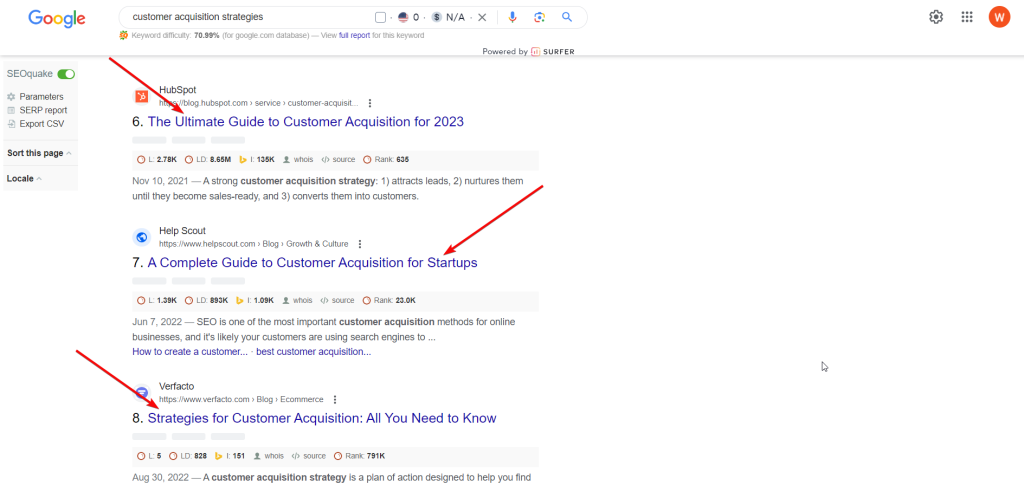
Let’s say you want to write a piece of content targeting the keyword “Customer Retention Strategies”. Now, if you type the keyword on Google, a bunch of websites will show up on the topic. Your job is to open all the blog posts ranked on the 1st page and find keywords as well as content gaps therein.
Typical content gaps encompass a lack of content freshness, wow factor, completeness, and usability. That means if you find these pieces of content lack updated data, the ability to mesmerize, necessary info, and clarity for easy reading and understanding, you can cover these gaps in your content.
Ready to Bridge Content Gaps with Ai
In an age where information flows faster than ever before, the challenge of bridging content gaps has become increasingly vital. It can be done manually or using automatic keyword gap tools.
Among them, Ai tools can analyze vast amounts of data and utilize advanced natural language processing to identify and fill content gaps. As a result, you can ensure that your content is comprehensive and relevant to secure search engine rankings.
But which Ai assistant is best for SEO content gap analysis? 🤔
Presenting GetGenie Ai – An advanced content gap analysis tool and SEO assistant.
You can perform advanced SEO content gap analysis with the GetGenie Ai WordPress plugin or GetGenie playground web editor.
Let’s get ready to revolutionize your content strategy to bridge content gaps, ensuring seamless and engaging communication. 🥳
1. Keyword Analysis
Proper keyword analysis helps identify relevant topics and content opportunities. It also enables more effective content gap analysis and strategic content planning.
GetGenie Ai, the content gap analysis tool is designed with an advanced keyword analysis feature.
- Select the “Blog Wizard” template
- Write the keyword
- Turn on SEO mode
- Select the region (e.g. Global, US, India, Bangladesh)
- Next, click on the “Analyze keyword”
This functionality also helps you to keyword gaps in your content.
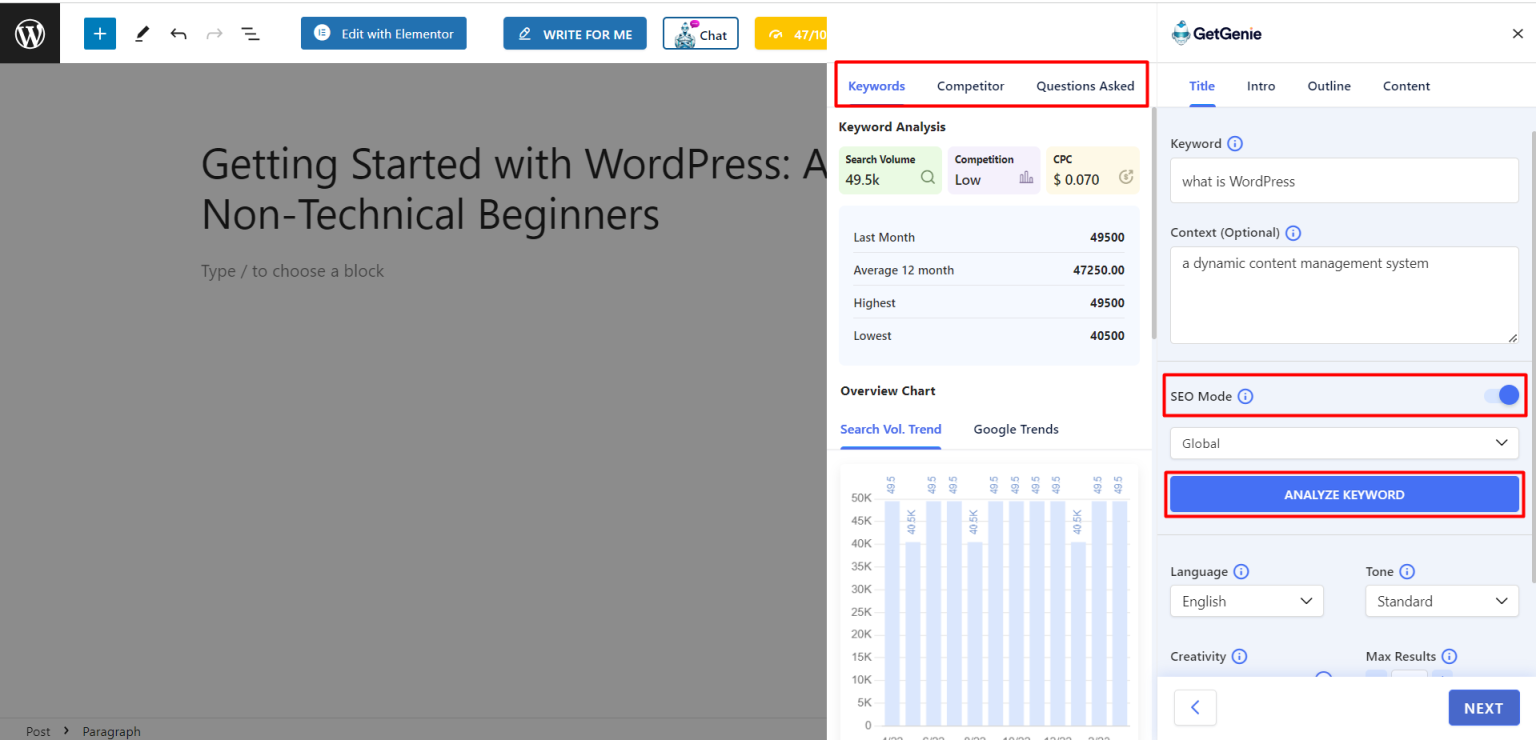
- You can now able to analyze the search volume for the last month, the average of the last 12 months, and competition level e.g. low or high, CPC, etc. using GetGenie, the keyword gap tool.

2. Competitor Analysis
Proper competitor analysis helps identify content gaps by revealing what topics and keywords competitors are targeting but you are not. For this,
- Fetch competitors’ data on the adjacent tab
Here you can find the competitor’s content details, and headings (H1, H2, H3….) to find out your content gap and optimize them accordingly.
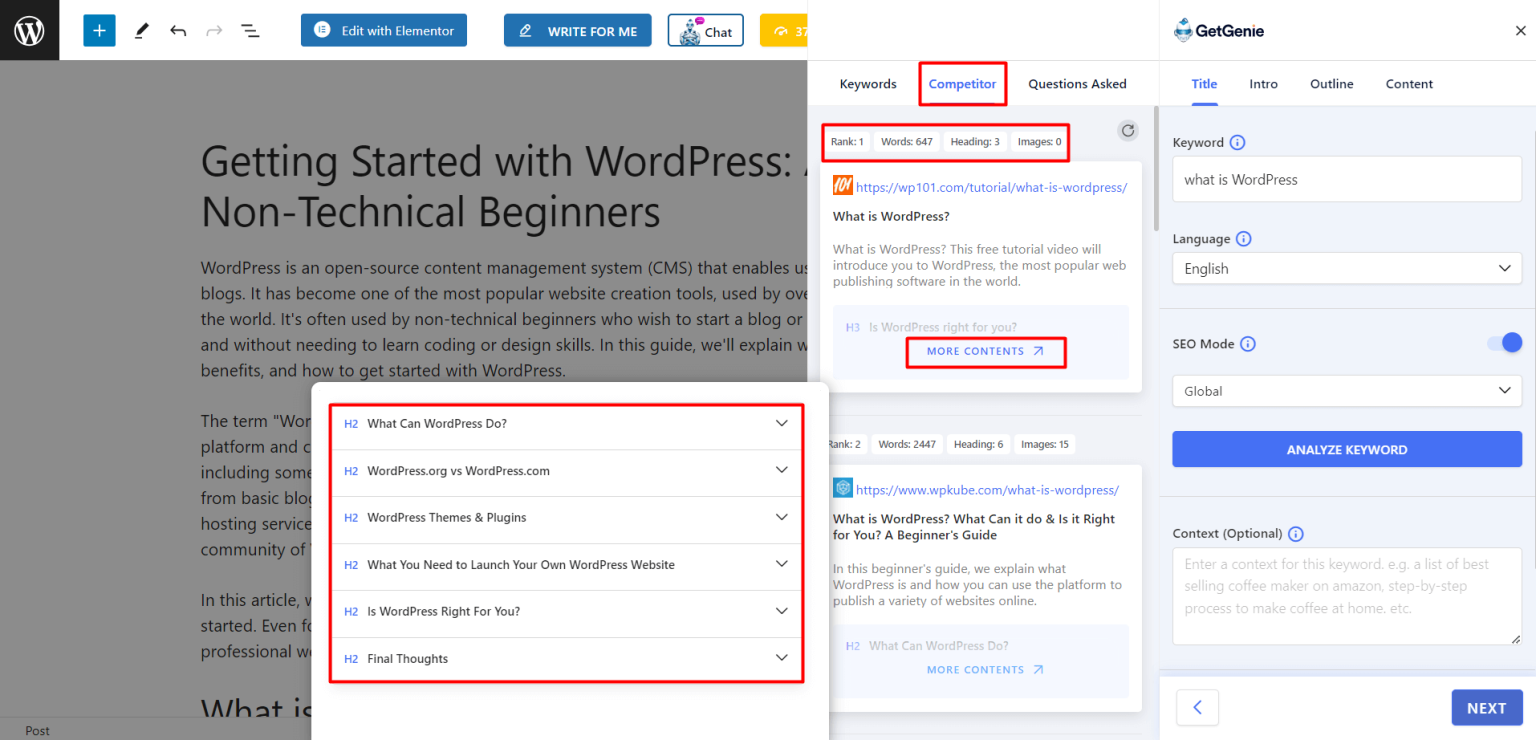
- Get frequently asked questions on the “Questions Asked” tab
In this section, you can get an overview of user intent for searching your given keyword as well as “people also asked” questions.
3. Content Gap Optimization
After that, generate new content or find out the gap in your exciting content.
Generate new content in just one click with GetGenie Ai following this documentation. Or simply open an existing blog post or copy the entire blog and paste it into the WordPress block editor or GetGenie’s playground.
For both platforms, you can see the “Content Score” tab.
- You can see your content score considering the NLP keywords analysis, readability, headings, internal links, images, and other on-page SEO factors. Besides, you will get recommendations for these factors to optimize your content properly.

- As you get a list of NLP keywords for your whole content, heading, and meta. You can use the suggested number of keywords to increase your content score mitigating your content gap and make your content more SEO-friendly.
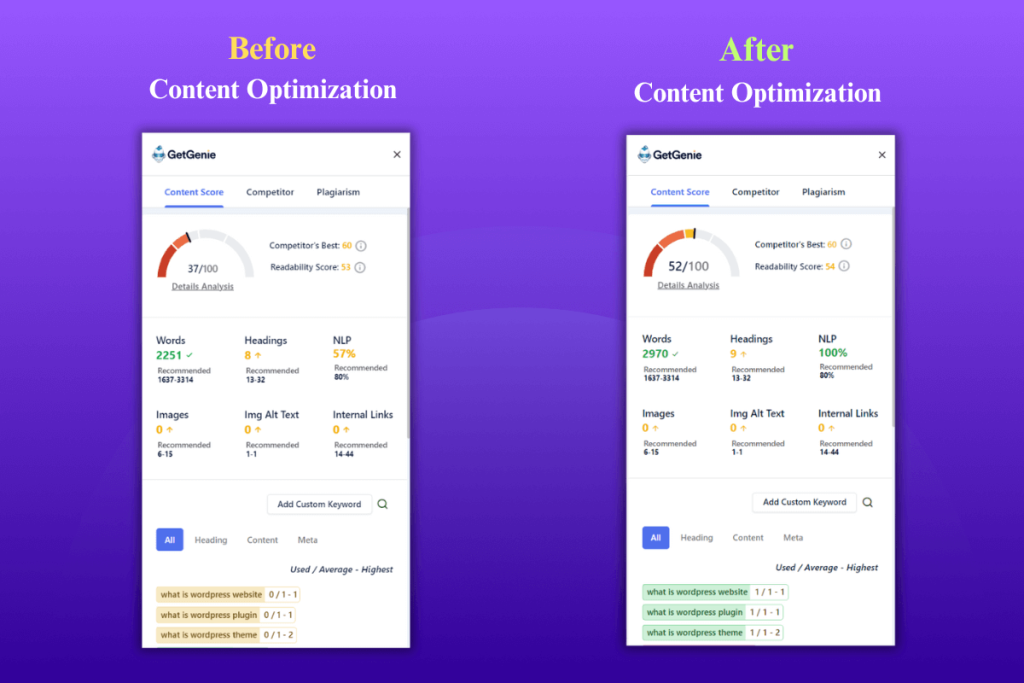
- To get a better view of competitor content gap analysis, you can navigate the competitor’s tab. Here you explore the SERP visualizer as well as do head-to-head analysis to improve your content.
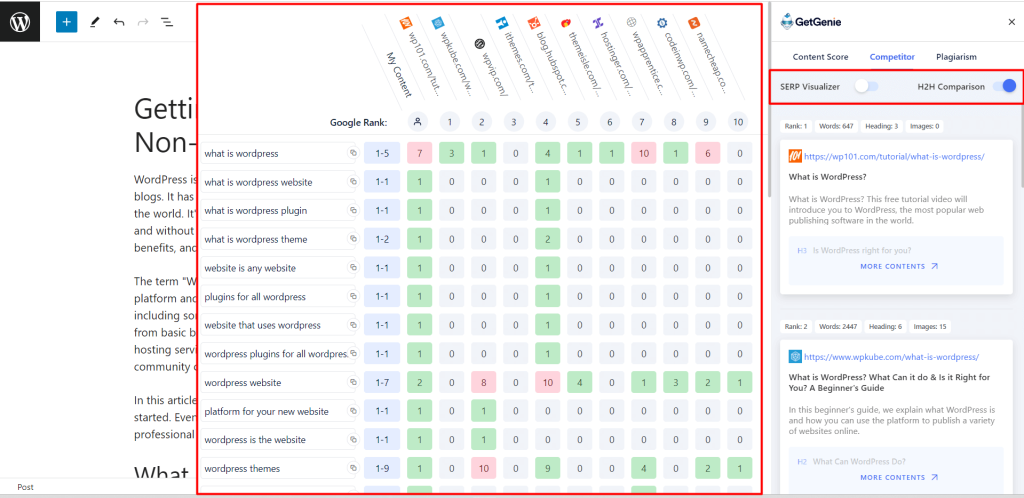
- In addition, you can check content originality which is also a vital part of content gap analysis. Checking content plagiarism with GetGenie Ai will help you in competitor content gap analysis by identifying areas where unique and fresh content is needed to fill gaps in existing material.
- If any plagiarism is found, you can utilize the content rewriter feature of GetGenie Ai. Amazing, right? 🥳
Final Words
When you write content targeting a keyword that your competitors have also targeted, it’s ultra-important that you find content gaps. If you write exactly what others have written, you can’t beat the competition to gain a higher position on the SERP.
Likewise, it’s also momentous to guide your website visitors with the right and appropriate content. Failure to do so will not only result in losing visitors but also tarnishing your brand’s image.
As we’ve summed up on “how to do a content gap analysis” in this blog, gear up to find gaps in your content, fill the gaps, and scale up the chances to outperform your competitors in Google’s SERP ranking!
And if you need to generate missing content for your marketing, you can always bank on an AI tool like GetGenie. It will generate any type of content for you in a flash!


